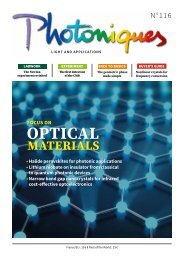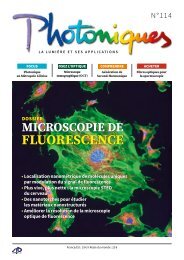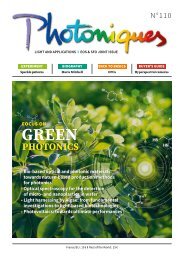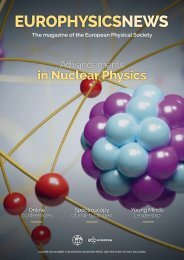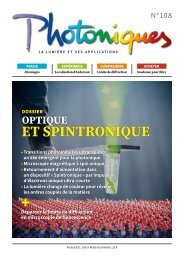EPN 53-3
Create successful ePaper yourself
Turn your PDF publications into a flip-book with our unique Google optimized e-Paper software.
FEATURES<br />
PLASMA MEDICINE<br />
m FIG. 2:<br />
Models of action,<br />
targets and<br />
applications of<br />
cold atmospheric<br />
plasmas (CAPs).<br />
. FIG. 3:<br />
Treatment with CAP<br />
delivers exogenous<br />
ROS bringing the<br />
metabolically more<br />
active cancer cells<br />
over the survival/<br />
death threshold.<br />
regeneration and wound healing (e.g. diabetic leg<br />
healing, ulcers, burns, etc.), with potential implications in<br />
the cosmetics field (e.g. skin regeneration, scar treatment,<br />
etc.), as well as cancer therapy (e.g. melanoma, glioblastoma,<br />
colon cancer, etc.).<br />
For instance, different atmospheric pressure plasma<br />
jets, which have been recently commercialized, have<br />
demonstrated their effectiveness at supporting the healing<br />
of non-infected acute wounds (kINPen, PlasmDERM,<br />
SteriPlas, Plason, PlasmaCare) [10]. To date, these<br />
plasma sources have also been applied in the treatment<br />
of long-lasting chronic and infected wounds, particularly<br />
in cases where conventional treatment have failed,<br />
with evidence in vitro and in vivo with studies in animals,<br />
that have led to the initiation of the first clinical trials.<br />
In diabetic patients with chronic leg and venous ulcers,<br />
plasma-treated patients experienced accelerated wound<br />
healing [5]. These results suggest that wound healing may<br />
be accelerated due to the simultaneous stimulation of tissue<br />
regeneration and angiogenesis. The results observed<br />
in such studies enable this vision of CAP technology on<br />
its way to becoming a clinical routine for wound healing<br />
and skin treatment. This regenerative potential of CAP<br />
on skin is currently being explored in the anti-aging and<br />
skin-wellness industry. This capacity of plasmas to stimulate<br />
tissue regeneration and repair can also be exploited<br />
for other tissues [11], opening new avenues that deserve<br />
further exploration.<br />
Recent advances in plasma medicine have been exploiting<br />
the potential use of CAP in cancer therapies.<br />
Cancer is a leading cause of death worldwide and despite<br />
the enormous amount of research and rapid developments<br />
seen during the past decade, cancer treatment is<br />
still challenging. In this sense, one key aspect which is<br />
attracting increased attention is the ability of CAPs to<br />
selectively kill cancer cells without damaging the surrounding<br />
tissues, thus offering a less aggressive solution<br />
compared to common anticancer therapies (i.e.<br />
chemotherapy and radiotherapy). The anticancer effects<br />
of CAP have been, at least in part, related to the<br />
RONS generated by plasmas, which are important mediators<br />
in stem cell biology. In fact, high levels of RONS<br />
have long been suggested to be detrimental to cellular<br />
health, and adding high amounts of exogenous RONS<br />
can induce cell cycle arrest, while higher doses lead to<br />
the induction of apoptotic and/or necrotic cell death<br />
(Figure 3). In this context, cancer cells are metabolically<br />
more active than healthy cells, thereby generating<br />
higher amount of intrinsic RONS. For this reason,<br />
delivering plasma with low exogenous RONS, triggers<br />
cancer cells to surpass the toxicity threshold and activate<br />
apoptosis without affecting normal cells of the<br />
surrounding healthy tissue. Interestingly, many studies<br />
demonstrated that indirect treatment using PTLs exert<br />
very similar effects compared to direct CAP treatment<br />
what could be particularly favorable in the treatments<br />
of areas harder to reach and an injection of PTLs may<br />
be a suitable alternative [12].<br />
Quo Vadis, plasma medicine?<br />
Merging physics, chemistry, and engineering with medical<br />
science gave rise to plasma medicine, which aims to<br />
develop novel and innovative technologies to improve the<br />
quality of life of patients and their families. The recent<br />
advancements in the field have demonstrated the great<br />
versatility of CAP systems and their ability to induce,<br />
mainly through RONS delivery, specific biological responses<br />
in pathogens (bacteria, viruses, yeasts and fungi),<br />
cells (healthy and cancellous), and living tissues. This has<br />
opened the door to a myriad of applications on the edge<br />
of tissue engineering and regenerative medicine such as<br />
eradication of biofilms, wound-healing, treatment of neurodegenerative<br />
diseases or cancer therapy. Nevertheless,<br />
22 <strong>EPN</strong> <strong>53</strong>/3



